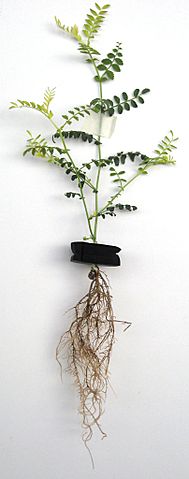Root rot is a common yet dangerous disease that infects plants. And especially houseplants. What makes root rot hard disease to handle is that its symptoms don’t appear in the plant until the damage already occurs. Since root rot happens underground.
Overwatering is the main cause of root rot. Since the excessive water takes the oxygen space. And roots need oxygen as much as water.
The lake of oxygen causes the roots to rot and decay. The other consequence that overwatering causes is activating the soil’s funges.
Your plant’s soil contains a lot of fungi types but it is dormant and inactive when the soil under normal healthy conditions ( the right amount of watering and moisture).
But when the soil became waterlogged, this gives life to the dangerous fungus( shifting them from dormant state to active state).
That fungus reproduces in the soil and starts to attack the plant’s roots, and then spread through roots very fast which causes roots to rot.
What does root rot look like!
It is not easy to diagnose plant diseases. Since most diseases will show similar symptoms. so it is a fair question to ask: what does root rot look like?!
when your plant’s leaves start to yellowing and wilting and its growth seems to be slow. Those are root rot symptoms as they also might be other disease symptoms.
As I mentioned earlier when plants are facing problems they tend to show the same signs like leaves turn to yellow, wilting, no to little growth…etc.
The right action to take when your plant show any unhealthy signs is to check its roots first. to know if it has root rot or other issues.
You do so, by removing the plant from the soil and checking its roots. The healthy roots have a white color and firm feeling when you touch it.
Although few plants have other roots colors but they will feel strong and firm when you touch them.
Rotted roots look black and feel mushy. Also, they are week and they may fall when you touch them while you are checking.

Chickpea plant with root rot. By Bjornwireen – Own work, CC BY-SA 3.0, https://commons.wikimedia.org/w/index.php?curid=8984980
Root rot treatment
I know that losing your plant is something unpleasant. since you took care of it and it became part of your life.
You want to do whatever you can to save it from root rot. If you notice the symptoms which I mentioned before take the following actions:
1. Check plant’s roots
You do so by gently removing your plant from the soil. If you find the soil stuck in the pot, try to loosen it genteelly.
After you griped out the plant’s soil check its roots. if you found it has brown to black, weak and mushy roots. this means the problem is root rot.
2. Clean the roots
Gently shake the roots to drop the soil. While you doing so, some roots may fall. This another sign for root rot. because infected roots are weak.
Then put your plant’s roots under running water to wash it from the remaining soil.
3. Trim infected roots
Use a clean and sterilized pair of shears to trim away any infected roots. It is important to cut all rotted roots if you want to increase the odds of your plant’s survival.
4. Use fungicide solution
There is a different fungicide. and each type kills a certain type of fungus. Therefore it is vital to know which fungi type caused your plant’s roots to rot.
When using chemical fungicide be careful and use it with caution. follow the product’s instructions.
And keep it away from children and pet reach. You can use cinnamon as a natural fungicide.
You do so by dusting the remaining roots with cinnamon powder. The cinnamon powder will create an unfavorable environment for fungus. Which will leads to their death.
5. Change the rotted soil
Since your plant has roots rot this means that soil is already full of active fungi. Remove the old soil and clean the pot with a bleach solution.
Then replant your plant in fresh soil. Make sure to use good drainage soil.
6.Trim your plant foliage
After you trim the affected roots. The root system needs energy resources to grow back. Trim the plants leaves significantly to let the plant focuses its energy on developing new roots instead of using it to support the foliage.
Make sure to clean and sterilize the pair of shears before using them. You don’t want to infect the foliage with the disease.
How to prevent root rot
It is wiser to know how to prevent root rot from happing rather than treating it. Follow the below chick list for root rot prevention.
1. Use well-drained pot
The main cause of root rot is an excessive amount of water in the root zone. Therefore make sure the pot you use has enough holes for water drainage.
2. Plant in the right soil
Use well-drained soil for your house plants. And avoid using garden soil for container plants.
Because it compacts easily and gives little to no space for the oxygen to flow. Besides, it doesn’t allow the water to drain. Which definitely causes roots to rot.
3. keep the right watering schedule
Don’t stress your plants with overwatering. Most plants require the topsoil to dry out before the next watering.
Make sure the two inches of topsoil is dry before watering and plan your watering schedule accordingly.
4. Aerate the soil to prevent root rot
Aerate your plant’s soil every two weeks by using a chopstick to make holes through the topsoil. You might hit some roots while you are doing so.
But don’t worry! the benefits of aerating the soil to allow the oxygen to flow freely through the soil, and water to drain properly overweight the cost of hitting a few roots.

